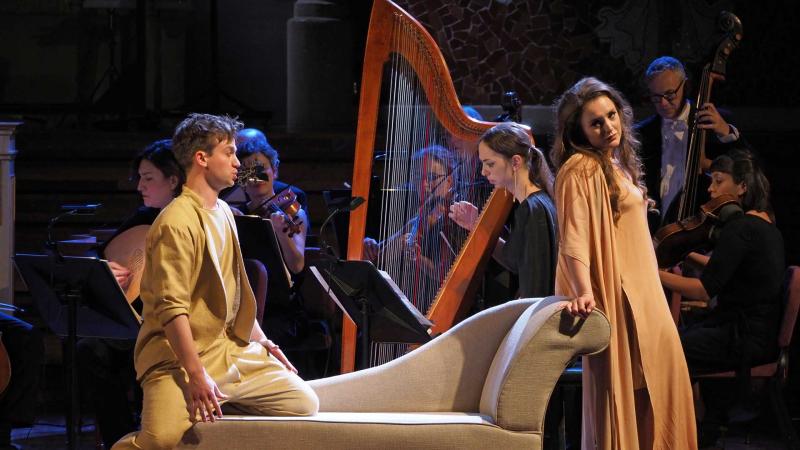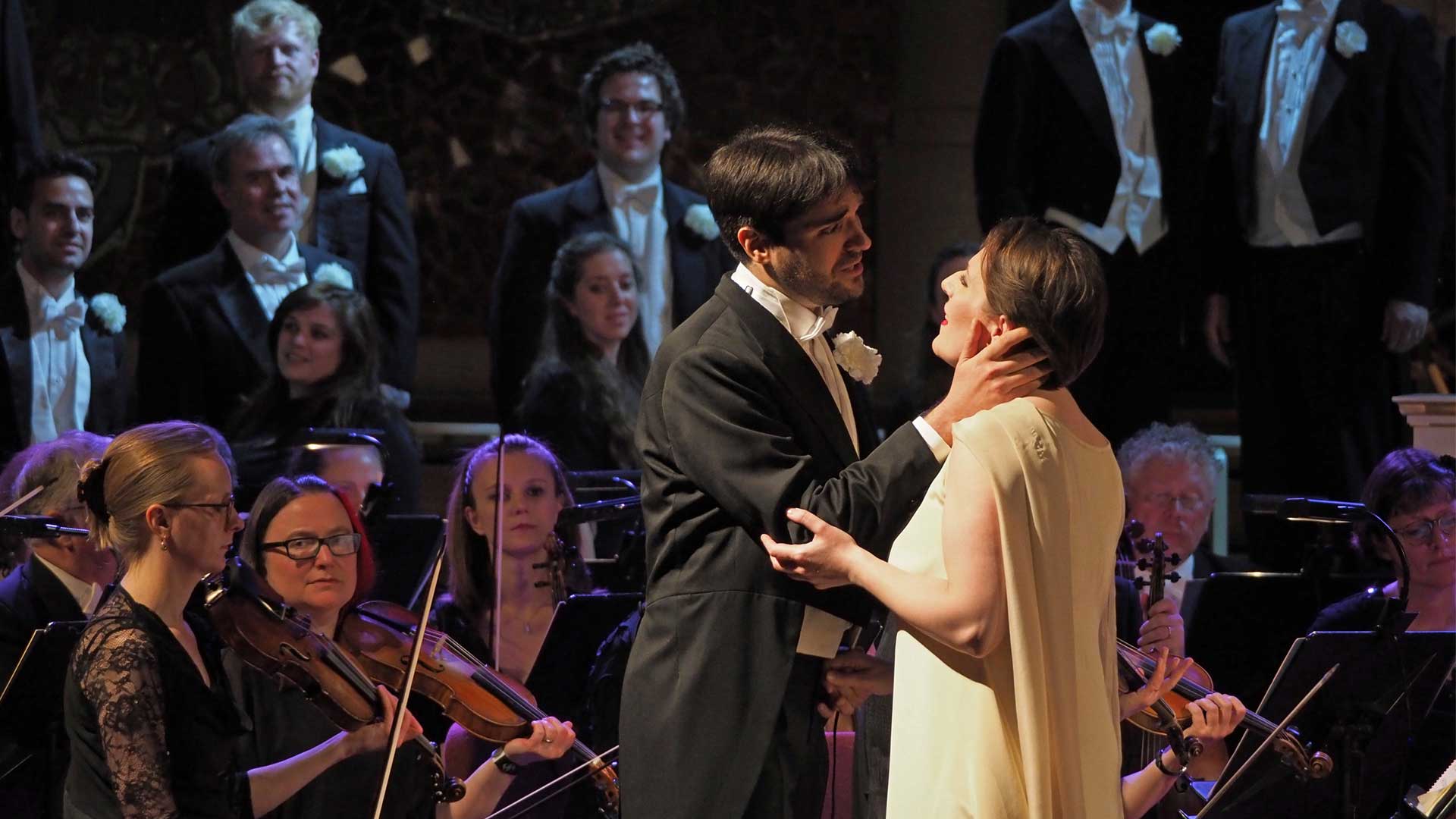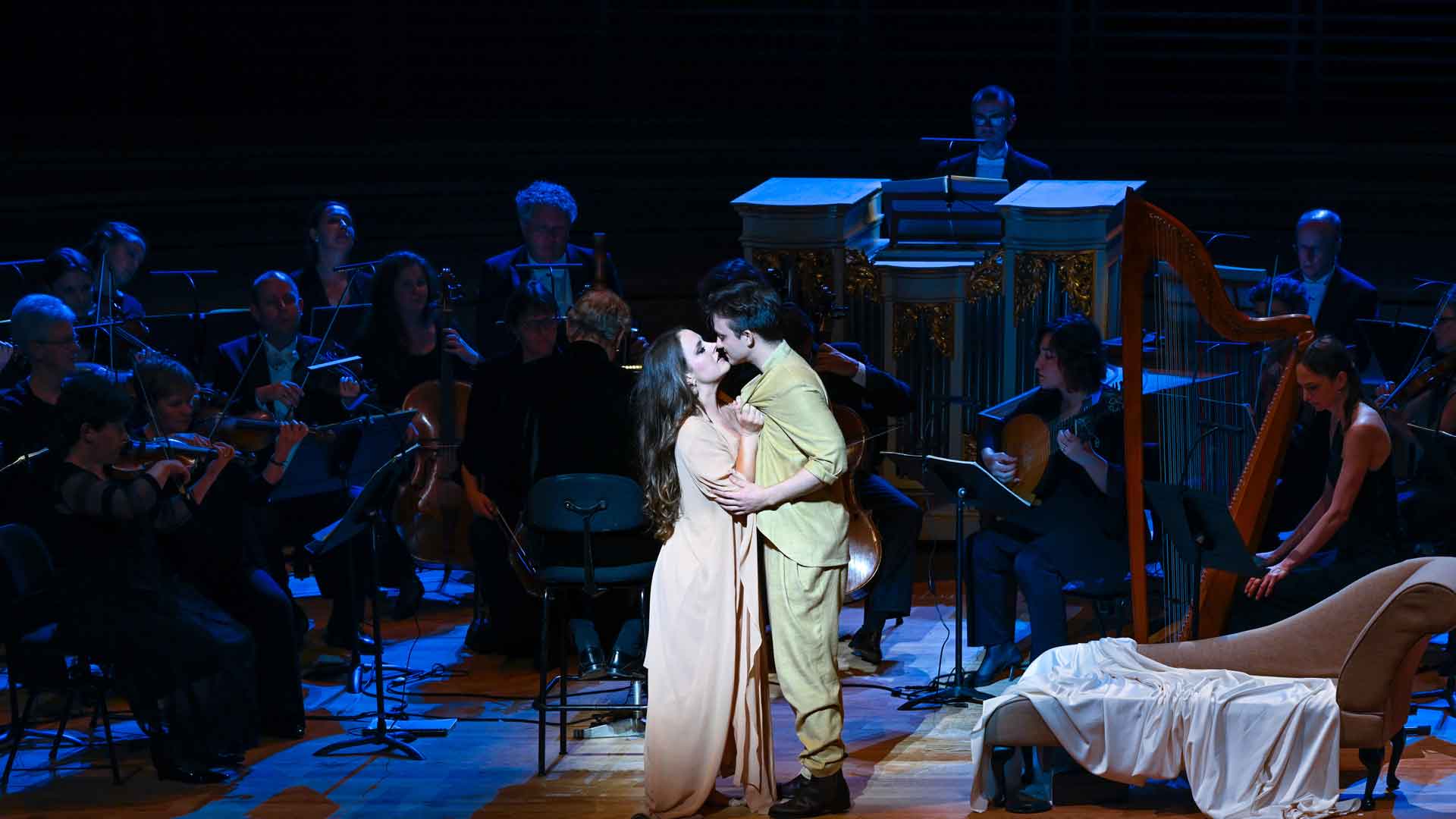Semele, Monteverdi Choir, EBS, Gardiner, Alexandra Palace review - Handel's cornucopia lavishly served | reviews, news & interviews
Semele, Monteverdi Choir, EBS, Gardiner, Alexandra Palace review - Handel's cornucopia lavishly served
Semele, Monteverdi Choir, EBS, Gardiner, Alexandra Palace review - Handel's cornucopia lavishly served
No 'secular oratorio' in these hands, but an ultimately electrifying opera

Louise Alder, lyric soprano of the moment and vivacity incarnate, had yet to be born when John Eliot Gardiner made his first recording of Handel's Semele with the Monteverdi Choir and English Baroque Soloists in 1981.
Circumstances for the company's only UK presentation - it is surrounded by performances in Paris, Barcelona, Milan and Rome - were not entirely happy at the start. Audience having been funnelled in to the crumbling temple of delights that is Alexandra Palace's wide, tall theatre, the performance began 20 minutes late. After the rollicking Overture, Gardiner getting the usual bite and lilt from the EBS as perfect companions throughout the action, and in a surprisingly good if dry acoustic, you just wanted the Monteverdi Choir to sit still. The best of professional choral singers, but hardly trained for stage work, their business with chairs at the opening nuptials of Semele to Athamas before Jupiter whisks her to the empyrean looked a bit amateurish. Thomas Guthrie's "concert staging" is not of the most elegant, despite designer couture by Patricia Hofstede and some atmospheric lighting effects from Rick Fisher.  The overall line-up is variable. Three supporting sopranos it would be kinder not to name don't really cut the operatic mustard. True bass Gianluca Buratto is very loud as Cadmus, the father of Semele and Ino, much more effective as Somnus, awakening from the depths of the two bassoons who play at his head at the start of the third act. Counter-tenor Carlo Vistoli makes a lovely sound as the dramatically more or less otiose Athamas; it's good that he gets his final celebratory aria, not on Gardiner's recording, but it's a maddening dramatic hold-up between the superb choral response to Semele's death and the final celebration of Bacchus rising from her ashes. Outdoing him for doughtiness is contralto Lucile Richardot as Ino, the sister he prefers (pictured above with Vistoli); those redoubtable chest tones are better brought into play when she takes on jealous Juno, though there could be more on-the-note singing and a more perceptive director than Guthrie would have got her to rein in the flouncing expression of her ire.
The overall line-up is variable. Three supporting sopranos it would be kinder not to name don't really cut the operatic mustard. True bass Gianluca Buratto is very loud as Cadmus, the father of Semele and Ino, much more effective as Somnus, awakening from the depths of the two bassoons who play at his head at the start of the third act. Counter-tenor Carlo Vistoli makes a lovely sound as the dramatically more or less otiose Athamas; it's good that he gets his final celebratory aria, not on Gardiner's recording, but it's a maddening dramatic hold-up between the superb choral response to Semele's death and the final celebration of Bacchus rising from her ashes. Outdoing him for doughtiness is contralto Lucile Richardot as Ino, the sister he prefers (pictured above with Vistoli); those redoubtable chest tones are better brought into play when she takes on jealous Juno, though there could be more on-the-note singing and a more perceptive director than Guthrie would have got her to rein in the flouncing expression of her ire.
You might question why Jupiter appears in the form of a sweet choral-scholar-tenor type; the role demands the presence of the likes of Anthony Rolfe-Johnson, unsurpassable on the recording, or John Mark Ainsley in Robert Carsen's gorgeous ENO production. But young Hugo Hymas sings with unremitting beauty and style; the da capo section of "Wher'er you walk" takes us to a special enchanted place, and his part in the denouement is not disappointing.  Unquestionably, though, the vocal honours belong to the chorus, so sprited in feting the joys above, and to Alder (pictured above with Hymas, Gardiner and the EBS), proving that she was robbed of the main award, if not the audience prize, in the 2017 BBC Cardiff Singer of the World Competition. She inhabits every move and phrase with natural intensity and perfect instinct, manages to blend with Richardot in the Semele/Ino duet and goes along with Guthrie's best idea for a da capo aria, "Myself I shall adore," starting out with mockery of Juno-as-Ino's "take a look in the mirror" before succumbing.
Unquestionably, though, the vocal honours belong to the chorus, so sprited in feting the joys above, and to Alder (pictured above with Hymas, Gardiner and the EBS), proving that she was robbed of the main award, if not the audience prize, in the 2017 BBC Cardiff Singer of the World Competition. She inhabits every move and phrase with natural intensity and perfect instinct, manages to blend with Richardot in the Semele/Ino duet and goes along with Guthrie's best idea for a da capo aria, "Myself I shall adore," starting out with mockery of Juno-as-Ino's "take a look in the mirror" before succumbing.
The climax of what has to be the early 18th century's most vivid dramatic sequence, "No, no, I'll take no less", is what you dream of in Handel - technically perfect fireworks, pure fire-breathing characterisation, as if Semele has actually gone mad in reaching too far (oddly, this was the only virtuoso number that got applause from a very quiet audience). What genius of Handel to give the lightning-blasted girl the bipolar opposite of this excess as Alder reduces the voice to a sliver of sound for the expiration. For all this, it was well worth an hour and a half's journey home after the show finished just past 11pm.
rating
Explore topics
Share this article
The future of Arts Journalism
You can stop theartsdesk.com closing!
We urgently need financing to survive. Our fundraising drive has thus far raised £49,000 but we need to reach £100,000 or we will be forced to close. Please contribute here: https://gofund.me/c3f6033d
And if you can forward this information to anyone who might assist, we’d be grateful.

Subscribe to theartsdesk.com
Thank you for continuing to read our work on theartsdesk.com. For unlimited access to every article in its entirety, including our archive of more than 15,000 pieces, we're asking for £5 per month or £40 per year. We feel it's a very good deal, and hope you do too.
To take a subscription now simply click here.
And if you're looking for that extra gift for a friend or family member, why not treat them to a theartsdesk.com gift subscription?
more Opera
 La bohème, Opera North review - still young at 32
Love and separation, ecstasy and heartbreak, in masterfully updated Puccini
La bohème, Opera North review - still young at 32
Love and separation, ecstasy and heartbreak, in masterfully updated Puccini
 Albert Herring, English National Opera review - a great comedy with depths fully realised
Britten’s delight was never made for the Coliseum, but it works on its first outing there
Albert Herring, English National Opera review - a great comedy with depths fully realised
Britten’s delight was never made for the Coliseum, but it works on its first outing there
 Carmen, English National Opera review - not quite dangerous
Hopes for Niamh O’Sullivan only partly fulfilled, though much good singing throughout
Carmen, English National Opera review - not quite dangerous
Hopes for Niamh O’Sullivan only partly fulfilled, though much good singing throughout
 Giustino, Linbury Theatre review - a stylish account of a slight opera
Gods, mortals and monsters do battle in Handel's charming drama
Giustino, Linbury Theatre review - a stylish account of a slight opera
Gods, mortals and monsters do battle in Handel's charming drama
 Susanna, Opera North review - hybrid staging of a Handel oratorio
Dance and signing complement outstanding singing in a story of virtue rewarded
Susanna, Opera North review - hybrid staging of a Handel oratorio
Dance and signing complement outstanding singing in a story of virtue rewarded
 Ariodante, Opéra Garnier, Paris review - a blast of Baroque beauty
A near-perfect night at the opera
Ariodante, Opéra Garnier, Paris review - a blast of Baroque beauty
A near-perfect night at the opera
 Cinderella/La Cenerentola, English National Opera review - the truth behind the tinsel
Appealing performances cut through hyperactive stagecraft
Cinderella/La Cenerentola, English National Opera review - the truth behind the tinsel
Appealing performances cut through hyperactive stagecraft
 Tosca, Royal Opera review - Ailyn Pérez steps in as the most vivid of divas
Jakub Hrůša’s multicoloured Puccini last night found a soprano to match
Tosca, Royal Opera review - Ailyn Pérez steps in as the most vivid of divas
Jakub Hrůša’s multicoloured Puccini last night found a soprano to match
 Tosca, Welsh National Opera review - a great company reduced to brilliance
The old warhorse made special by the basics
Tosca, Welsh National Opera review - a great company reduced to brilliance
The old warhorse made special by the basics
 BBC Proms: The Marriage of Figaro, Glyndebourne Festival review - merriment and menace
Strong Proms transfer for a robust and affecting show
BBC Proms: The Marriage of Figaro, Glyndebourne Festival review - merriment and menace
Strong Proms transfer for a robust and affecting show
 BBC Proms: Suor Angelica, LSO, Pappano review - earthly passion, heavenly grief
A Sister to remember blesses Puccini's convent tragedy
BBC Proms: Suor Angelica, LSO, Pappano review - earthly passion, heavenly grief
A Sister to remember blesses Puccini's convent tragedy
 Orpheus and Eurydice, Opera Queensland/SCO, Edinburgh International Festival 2025 review - dazzling, but distracting
Eye-popping acrobatics don’t always assist in Gluck’s quest for operatic truth
Orpheus and Eurydice, Opera Queensland/SCO, Edinburgh International Festival 2025 review - dazzling, but distracting
Eye-popping acrobatics don’t always assist in Gluck’s quest for operatic truth

Add comment